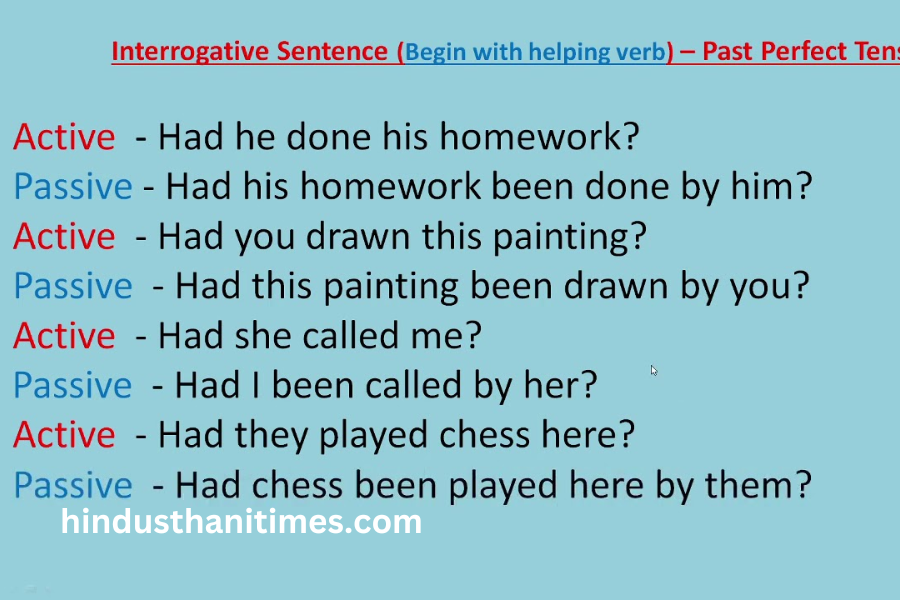The past perfect tense is a verb tense used to describe an action that was completed before another action in the past. It helps us establish a clear sequence of events and is often used when telling stories or describing past experiences. In this article, we will explore the active and passive voice forms of the past perfect tense and provide examples to illustrate their usage.
Understanding Active and Passive Voice
Before we delve into the examples of the past perfect tense in active and passive voice, let’s first understand what active and passive voice mean. In active voice, the subject of the sentence performs the action, while in passive voice, the subject receives the action. Active voice is generally more direct and concise, while passive voice is used when the focus is on the recipient of the action rather than the doer.
Examples of Past Perfect Tense in Active Voice
In active voice, the subject of the sentence performs the action. Here are a few examples of sentences in the past perfect tense using active voice:
- John had finished his homework before he went to bed.
- In this example, John is the subject who completed the action of finishing his homework before going to bed.
- The team had won the championship before the coach retired.
- In this sentence, the team is the subject that accomplished the action of winning the championship before the coach retired.
- She had already eaten dinner by the time her friends arrived.
- Here, the subject “she” completed the action of eating dinner before her friends arrived.
Examples of Past Perfect Tense in Passive Voice
In passive voice, the subject receives the action rather than performing it. Let’s take a look at some examples of sentences in the past perfect tense using passive voice:
- The book had been read by many people before it was published.
- In this sentence, the book is the subject that received the action of being read by many people before it was published.
- The building had been repaired before the storm hit.
- Here, the building is the subject that underwent the action of being repaired before the storm arrived.
- The cake had been eaten by the time I got home.
- In this example, the cake is the subject that experienced the action of being eaten before the speaker arrived home.
How to Form Past Perfect Tense in Active Voice
Forming the past perfect tense in active voice requires using the auxiliary verb “had” followed by the past participle of the main verb. Here’s a step-by-step guide on how to form the past perfect tense in active voice:
- Start with the subject of the sentence.
- Add the auxiliary verb “had.”
- Follow it with the past participle form of the main verb.
- Complete the sentence with any additional information.
For example:
- Subject + had + past participle + additional information
How to Form Past Perfect Tense in Passive Voice
To form the past perfect tense in passive voice, we use the auxiliary verb “had been” followed by the past participle of the main verb. Here’s a simple guide on how to form the past perfect tense in passive voice:
- Begin with the subject of the sentence.
- Add the auxiliary verb “had been.”
- Follow it with the past participle form of the main verb.
- Complete the sentence with any additional information.
For example:
- Subject + had been + past participle + additional information
Common Mistakes to Avoid when Using Past Perfect Tense
While using the past perfect tense, it’s essential to be aware of common mistakes that writers often make. Here are a few mistakes to avoid:
- Using the past perfect tense when the sequence of events is already clear without it.
- Mixing up the active and passive voice forms.
- Forgetting to use the auxiliary verb “had” in past perfect tense sentences.
By being mindful of these mistakes, you can ensure that your use of the past perfect tense is accurate and enhances the clarity of your writing.
Practice Exercises for Past Perfect Tense in Active and Passive Voice
To reinforce your understanding of the past perfect tense, here are some practice exercises. Rewrite the following sentences in the past perfect tense, both in active and passive voice:
- The train arrived before the passengers boarded.
- The letter had been written before the post office closed.
- She had completed the project before the deadline.
Take your time to complete these exercises and compare your answers with the suggested solutions to gauge your progress.
Importance of Using Past Perfect Tense in Writing
Using the past perfect tense in your writing can provide clarity and coherence to your narratives. It allows you to establish a precise chronological order of events, creating a smooth flow for your readers. By using the past perfect tense, you can convey a sense of completion and highlight the relationship between different past actions.
Whether you’re writing a short story, an essay, or a report, the past perfect tense adds depth and sophistication to your writing, making it more engaging and enjoyable to read.
Conclusion
In conclusion, the past perfect tense is a valuable tool for writers to express the sequence of events in the past. By understanding the active and passive voice forms of the past perfect tense and practicing their usage, you can enhance the clarity and effectiveness of your writing.
Remember to use the active voice when you want to emphasize the doer of the action and the passive voice when the focus is on the recipient of the action. Avoid common mistakes, such as using the past perfect tense unnecessarily or forgetting to include the auxiliary verb “had.”
By mastering the past perfect tense, you can elevate your writing to new heights and captivate your readers with compelling narratives. So, go forth and experiment with the past perfect tense in your writing, and watch your prose come alive with vivid storytelling.



